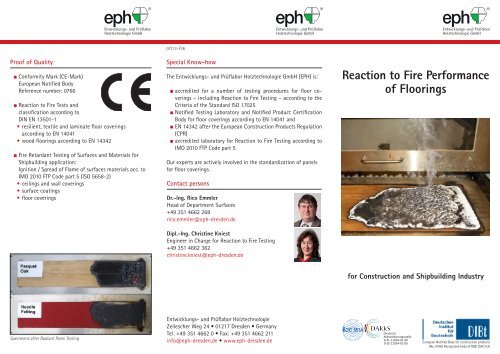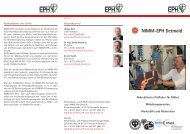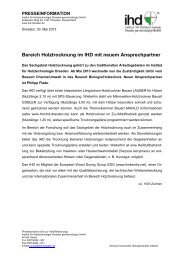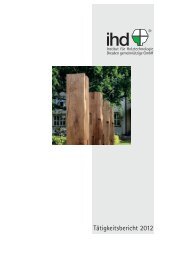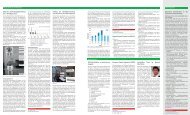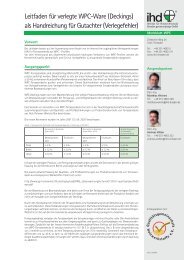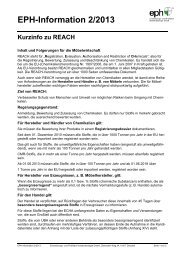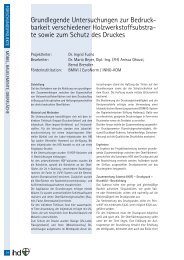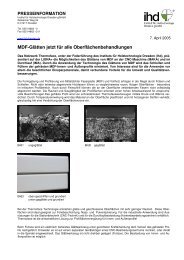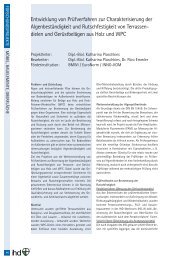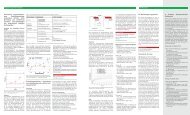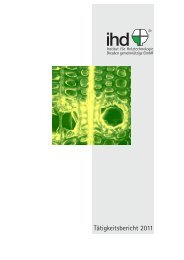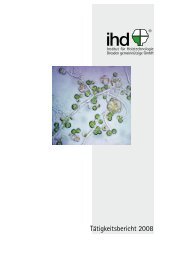Reaction to Fire Performance of Floorings - IhD
Reaction to Fire Performance of Floorings - IhD
Reaction to Fire Performance of Floorings - IhD
Create successful ePaper yourself
Turn your PDF publications into a flip-book with our unique Google optimized e-Paper software.
Pro<strong>of</strong> <strong>of</strong> Quality<br />
■■Conformity Mark (CE-Mark)<br />
European Notified Body<br />
Reference number: 0766<br />
■■<strong>Reaction</strong> <strong>to</strong> <strong>Fire</strong> Tests and<br />
classification according <strong>to</strong><br />
DIN EN 13501-1<br />
• resilient, textile and laminate floor coverings<br />
according <strong>to</strong> EN 14041<br />
• wood floorings according <strong>to</strong> EN 14342<br />
■■<strong>Fire</strong> Retardant Testing <strong>of</strong> Surfaces and Materials for<br />
Shipbuilding application:<br />
Ignition / Spread <strong>of</strong> Flame <strong>of</strong> surfaces materials acc. <strong>to</strong><br />
IMO 2010 FTP Code part 5 (ISO 5658-2)<br />
• ceilings and wall coverings<br />
• surface coatings<br />
• floor coverings<br />
07/13-F36<br />
Special Know-how<br />
The Entwicklungs- und Prüflabor Holztechnologie GmbH (EPH) is:<br />
■■accredited for a number <strong>of</strong> testing procedures for floor coverings<br />
– including <strong>Reaction</strong> <strong>to</strong> <strong>Fire</strong> Testing – according <strong>to</strong> the<br />
Criteria <strong>of</strong> the Standard ISO 17025<br />
■■Notified Testing Labora<strong>to</strong>ry and Notified Product Certification<br />
Body for floor coverings according <strong>to</strong> EN 14041 and<br />
■■EN 14342 after the European Construction Products Regulation<br />
(CPR)<br />
■■accredited labora<strong>to</strong>ry for <strong>Reaction</strong> <strong>to</strong> <strong>Fire</strong> Testing according <strong>to</strong><br />
IMO 2010 FTP Code part 5<br />
Our experts are actively involved in the standardization <strong>of</strong> panels<br />
for floor coverings.<br />
Contact persons<br />
Dr.-Ing. Rico Emmler<br />
Head <strong>of</strong> Department Surfaces<br />
+49 351 4662 268<br />
rico.emmler@eph-dresden.de<br />
Dipl.-Ing. Christine Kniest<br />
Engineer in Charge for <strong>Reaction</strong> <strong>to</strong> <strong>Fire</strong> Testing<br />
+49 351 4662 362<br />
christine.kniest@eph-dresden.de<br />
<strong>Reaction</strong> <strong>to</strong> <strong>Fire</strong> <strong>Performance</strong><br />
<strong>of</strong> <strong>Floorings</strong><br />
for Construction and Shipbuilding Industry<br />
Specimens after Radiant Panel Testing<br />
Entwicklungs- und Prüflabor Holztechnologie<br />
Zellescher Weg 24 • 01217 Dresden • Germany<br />
Tel: +49 351 4662 0 • Fax: +49 351 4662 211<br />
info@eph-dresden.de • www.eph-dresden.de<br />
Deutsche<br />
Akkredierungsstelle<br />
D-PL-11054-01-00<br />
D-ZE-11054-01-00<br />
European Notified Body for construction products<br />
(No. 0766) Recognized body <strong>of</strong> DIBt (SAC 03)
Radiant Panel Test acc. <strong>to</strong> EN ISO 9239-1<br />
In the Radiant Panel Test there is simulated the fire <strong>of</strong> a flanking<br />
wall and the falling down <strong>of</strong> a burning object simultaneously. The<br />
flooring sample with dimensions <strong>of</strong> 1050 mm x 230 mm, mounted<br />
horizontally in the testing chamber, is exposed <strong>to</strong> a radiant heat<br />
up <strong>to</strong> 12 kW/m² by a gas-fueled radiant heat source fastened in<br />
an angle <strong>of</strong> 30°. After a preheating <strong>of</strong> 2 min the flooring sample<br />
will be exposed <strong>to</strong> the “burning object” by ignition and moving<br />
forwards an in-line pilot burner.<br />
The further fire propagation <strong>of</strong> the meanwhile as a rule independently<br />
burning sample, measured as covered flame spread<br />
distance in dependence <strong>of</strong> the test duration is moni<strong>to</strong>red until<br />
extinguishment <strong>of</strong> the sample or the end <strong>of</strong> the test respectively.<br />
After the 30 min test duration the Critical Heat Flux CHF [kW/m²]<br />
related <strong>to</strong> the maximum flame spread distance is determined in<br />
accordance with the regular calibration.<br />
Besides the flame spread also the smoke production is evaluated.<br />
The measured parameter is the light attenuation in the flue channel<br />
<strong>of</strong> the testing device as the integral over the testing duration.<br />
Testing Procedures<br />
The reaction <strong>to</strong> fire performance <strong>of</strong> Construction Products is pro<strong>of</strong>ed<br />
by the classification according <strong>to</strong> DIN EN 13501-1.<br />
For floor coverings according <strong>to</strong> EN 14041 and EN 14342 as a rule<br />
the experimental classification in<strong>to</strong> the relevant <strong>Fire</strong> classes E fl<br />
up<br />
<strong>to</strong> B fl<br />
first is based on the testing procedure according <strong>to</strong> EN ISO<br />
11925-2 named as Single-flame Source Test and second on the<br />
Radiant-Panel-Test according <strong>to</strong> EN ISO 9239-1 (cf. table).<br />
Flame-retardant<br />
Normally flammable<br />
<strong>Fire</strong> class<br />
F fl<br />
B fl<br />
C fl<br />
D fl<br />
E fl<br />
Testing Procedure<br />
EN ISO 9239-1<br />
and<br />
EN ISO 11925-2<br />
t = 15 s (20 s)<br />
EN ISO 9239-1<br />
and<br />
EN ISO 11925-2<br />
t = 15 s (20 s)<br />
EN ISO 9239-1<br />
and<br />
EN ISO 11925-2<br />
t = 15 s (20 s)<br />
EN ISO 11925-2<br />
t = 15 s (20 s)<br />
Classification criteria<br />
CHF in kW/m²<br />
F s<br />
in mm<br />
CHF ≥ 8,0<br />
Smokeproduction<br />
s1, s2<br />
F S<br />
≤ 150 -<br />
CHF ≥ 4,5<br />
s1, s2<br />
F S<br />
≤ 150 -<br />
CHF ≥ 3,0<br />
s1, s2<br />
F S<br />
≤ 150 -<br />
F S<br />
≤ 150 -<br />
Highly flammable – no performance determined.<br />
Single-flame Source Test acc. <strong>to</strong> EN ISO 11925-2<br />
The Single-flame Source Test simulates the fire situation <strong>of</strong> a<br />
burning matchstick, falling down on the floor, whereas 20 s after<br />
beginning <strong>of</strong> the test by direct exposure <strong>to</strong> flame at surface<br />
for 15 s a maximal extent <strong>of</strong> flame F s<br />
≤ 150 mm is allowed<br />
corresponding <strong>to</strong> the requirements on floorings. The specimen<br />
with dimensions <strong>of</strong> 250 mm x 90 mm are vertically mounted<br />
in<strong>to</strong> the combustion box and flamed by a 20 mm long singleflame<br />
source with 45° angle against the surface.<br />
Spread <strong>of</strong> Flame according <strong>to</strong> IMO 2010 FTP Code part 5<br />
Materials intended for the use in the Shipbuilding industry<br />
have <strong>to</strong> meet the requirements <strong>of</strong> the International Maritime<br />
Organisation IMO. The following surface flammability criteria<br />
are tested:<br />
■■Critical Flux at Extinguishment CFE in kW/m²,<br />
■■Heat for sustained burning Q sb<br />
in MJ/m²,<br />
■■Total heat release Q t<br />
in MJ and<br />
■■Peak <strong>of</strong> heat release rate Q p<br />
in kW.<br />
The vertically mounted specimen with dimensions <strong>of</strong> 795 mm<br />
x 155 mm are exposed <strong>to</strong> a radiant heat up <strong>to</strong> 50 kW/m² by<br />
a gas-fueled radiant heater fastened in an angle <strong>of</strong> 15°and<br />
ignited by a pilot burner.<br />
Radiant Panel Test gemäß EN ISO 9239-19-1<br />
CHF... …Critical Heat Flux in kW/m²<br />
Fs....... …Maximal extent <strong>of</strong> flame in mm<br />
s1...... …Smoke production ≤ 750 %*min<br />
s2...... …not s1<br />
Spread <strong>of</strong> Flame according <strong>to</strong> IMO 2010 FTP Code part 5


